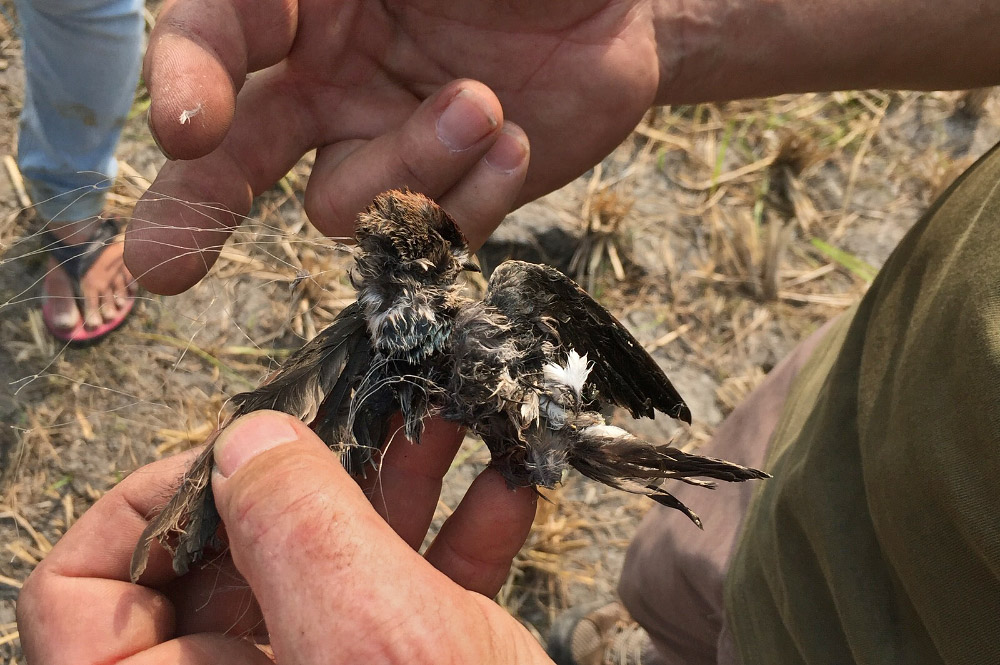 "
"
Rajarhat wetlands (a neighbourhood of Kolkata, in North 24 Parganas district) have become a poachers paradise with numerous trap nets being placed in strategic locations across water bodies, marshes and paddy fields. These nets are quite big (about 10-15 feet in length and about 4-5 feet in width) and strung across bamboo poles. The nets are made of strings so thin that they are not clearly visible from a distance unless viewed carefully. Birds fly into the nets and get entangled. Unable to escape, they wait for the poachers to come and slaughter them, or die a slow and painful death like the dead wire-tailed swallow we found ensnared in a wire mesh that we cut down.
Birders can help to prevent these massacres by being vigilant while birding and alerting the authorities so that immediate action can be taken to destroy the nets/apprehend the poachers. I request all birders/bird photographers who visit Rajarhat to keep in mind the following:
- Use your lens/binoculars to carefully scan the landscape (including fields and waterbodies) to search for fish nets/traps formed by strings wound around bamboo poles. Pay more attention to the areas near reed beds and water bodies.
- So far nets have been sighted in the (a) wetlands adjacent to the canal located on the opposite side of the main road from Eco Tourism Park. A pair of owl statues guards the turning from where the main road branches off and the side roads extends towards the canal.The end of the road is blocked by a low wall bearing the words “Road Closed” beyond which lies the canal and the marshes. (b) the marshes wetlands in and around the Hanuman Mandir and adjacent to the Eco Tourism Park and proposed deer park. This area is locally known as Hatiara. Please pay special attention to these areas.
- If you see nets/traps please take pictures and inform the Forest Department immediately. You may contact the Forest Department at the following numbers: 9830467210 (Mr Dilip Prasad, Wildlife Control Wing) and the 033-23346900 (Landline of Aranya Bhavan; please ask to speak to the Additional Divisional Forest Officer/Divisional Forest Officer and seek his/her assistance), 033-23357751, ext-217 (DFO Mr Sarajit Mukherjee, Aranya Bhavan). You may also alert other proactive birders to ensure that a conjoint effort is made to save the birds.
- Please remember that the nets once located must be dismantled at all costs. We cannot leave nets behind. Every single net can kill multiple birds and sometimes even a whole flock may get trapped in one net. It is therefore, imperative that a net once located is removed immediately. According to the information we garnered from local sources, the nets are placed by locals to trap birds and the placement of the nets also suggest the same.
- In case a poacher is seen please take his/her photograph and report the incident to the Forest Department/Wildlife Crime Control Wing. At the least share the pictures in all birding fora so that the photographs can be used for initiating an official complaint
Thanking all birders/bird photographers for their support.

 CI is a non-profit, non-commercial portal that aims to facilitate wildlife and nature conservation by providing reliable information and the tools needed to campaign effectively.
CI is a non-profit, non-commercial portal that aims to facilitate wildlife and nature conservation by providing reliable information and the tools needed to campaign effectively.



Chosen as 'Picture of the Week'
Rajarhat wetlands have become a poachers paradise with numerous trap nets being placed in strategic locations across water bodies, marshes and paddy fields.